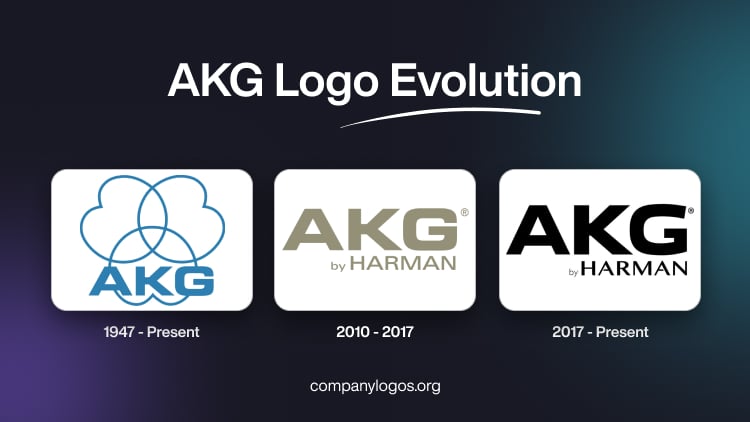
AKG Acoustics, commonly known as AKG, is a renowned Austrian audio engineering company known for its groundbreaking innovations in sound technology. It was founded in 1947 in Vienna by Dr Rudolf Görike and Ernst Pless and quickly rose to prominence as a pioneer in professional audio equipment.
It is known for designing some of the world’s most influential microphones, headphones, and wireless systems. The AKG logo has evolved alongside the expansion of the company and symbolises innovation, precision engineering, and trust. The article delves into the various logos designed by the company, among other details.
The Genesis of the AKG Logo (1947 – Present)
The original AKG logo that continues to date features a graphical emblem and the abbreviated wordmark “AKG” in blue. The emblem includes three geometric figures similar to flower petals. Curved inward, these figures crisscross each other and project a small indentation to their outer ends. The bottom of the emblem shows the uppercase wordmark “AKG” in a bold and geometric sans-serif typeface.

(2010 – 2017)
The logo iteration of 2010 did not have any graphical emblem but only the brand name in ochre colour. The minimalist wordmark in uppercase retained the style of the previous logo and carried the words “by HARMAN” as a tagline below. Written in thin letters, the tagline was positioned to the right. Both the wordmarks were written using a sans-serif typeface.

(2017 – Present)
Although the AKG logo is similar to the previous iteration in terms of design, the font, colour, and style have been changed. The wordmarks (including the tagline “by HARMAN”) are written in monochrome using a classic sans-serif typeface, which is similar to the Eurostile LT Pro Bold Extended font.
The font is characterised by its clean and sharp lines. The letters of the tagline show legs of varying thickness, and the crossbar of the letter “A” is open. The colour black makes the logo appear masculine, powerful, and laconic.

The Elements of the AKG Logo
Font
The AKG logotype in uppercase is written using a custom, geometric, and modern sans-serif typeface, where the letter “G” is shown with a slightly modernised contour. The similar font is Eurostile LT Pro Bold Extended.
Colour
The AKG logo is designed using a monochrome colour palette of black and white for easy legibility. The colour palette is confident, timeless, and powerful.
The History of AKG
AKG Acoustics, or Akustische und Kino-Geräte Gesellschaft m.b.H., when expanded, was founded in 1947 in Vienna, Austria, by two engineers, Dr Rudolf Görike and Ernst Pless. The two shared a vision to develop advanced sound technologies for cinema and broadcast applications in post-war Europe. Initially, AKG specialised in producing equipment for cinemas, namely, film projectors, loudspeakers, and microphones. The first products of the company, such as the DYN series microphones (1949), quickly established its reputation for precision engineering.
In 1953, AKG introduced the D12 microphone, which was the world’s first dynamic cardioid microphone. This landmark product became an industry standard for broadcasting and recording and was used extensively by radio stations and recording studios worldwide. During this period, AKG also created the C12 condenser microphone, which was famed for its natural sound and is still revered as a studio classic.
By the 1960s, AKG had expanded internationally, with its microphones and headphones adopted by major recording studios and broadcasters around the world. In 1959, AKG introduced its first headphones, the K50, which brought to the fore high-quality personal audio.
The 1970s marked the company’s transition from a European manufacturer to a global leader in audio technology. In fact, AKG’s K140 and K240 headphones became studio staples, known for their accuracy and durability. Their microphones were used by renowned musicians, sound engineers, and even in NASA space missions. These showed the reliability and innovation brought about by the company.
As digital audio technologies emerged, AKG continued to innovate. The company developed advanced wireless systems, studio monitors, and condenser microphones that catered to both professional and live performance markets. In 1994, AKG was acquired by Harman International Industries, a U.S.-based audio conglomerate. This acquisition brought AKG into a larger family of audio brands, namely, JBL and Harman Kardon, and provided new resources for its global expansion. However, despite the corporate changes, AKG maintained its engineering base in Vienna and preserved its European craftsmanship and heritage.
Under Harman’s leadership, AKG broadened its reach into the consumer electronics market. It produced high-fidelity headphones and earphones designed for everyday listeners. Its products combined professional-grade sound with sleek, modern design.
AKG’s reputation for quality led to partnerships with major music and technology companies. The brand became known for collaborations with Samsung, which later acquired Harman in 2017. Following this acquisition, AKG audio technology was integrated into Samsung’s flagship devices, including Galaxy smartphones, tablets, and laptops. Thus, AKG’s sound expertise was introduced to millions of users worldwide.
AKG remains a premium audio brand under the Harman (Samsung Electronics) umbrella. It continues to design high-performance microphones, headphones, and wireless systems for both professionals and consumers. While AKG’s operations are now global, the brand continues to honour its Viennese roots of blending European engineering precision with modern technological innovation. The company’s logo, featuring the iconic three-lobed emblem, still symbolises its deep connection to sound science and microphone design.
Interesting Facts About AKG
- AKG was established in Vienna, Austria, just after the Second World War, by Dr Rudolf Görike and Ernst Pless. The founders started out building cinema and audio equipment by hand in a small basement workshop before becoming one of the world’s leading audio innovators.
- The company’s full German name translates to “Acoustics and Cinema Equipment Company”. The name reflects its origins in producing sound systems and projectors for movie theatres.
- In 1953, AKG introduced the D12, the world’s first dynamic cardioid microphone. It revolutionised broadcasting and recording studios and became legendary for its deep, warm sound, especially on kick drums.
- In 1953, AKG brought out the C12 condenser microphone, which remains one of the most famous studio microphones ever made. Its distinctive sound was used by artists like The Beatles, Frank Sinatra, Stevie Wonder, and David Bowie, and it remains sought after by producers to this day.
- AKG developed the K50 in 1959, which was one of the world’s first on-ear (supra-aural) headphones. This innovation laid the groundwork for the company’s future dominance in headphone technology.
- AKG equipment has even travelled beyond Earth. Its microphones were used during NASA space missions, which is a testament to their reliability and precision engineering.
- The AKG logo, featuring three overlapping lobes, represents microphone polar patterns. It symbolises the company’s expertise in acoustics and sound capture.
- AKG microphones and headphones are industry standards in broadcasting, live sound, and recording studios. Models like the K240 headphones have been used in studios worldwide for decades.
- AKG is among the pioneers to have built headphones with a background noise cancellation feature.
- In 1994, AKG was acquired by Harman International and later became part of Samsung Electronics in 2017. Today, AKG sound technology is integrated into Samsung Galaxy smartphones, tablets, and laptops.
- AKG celebrated its 75th anniversary in 2022, which marked more than seven decades of pioneering work in professional and consumer audio.
Finally
The evolution of the AKG logo reflects the enduring commitment of the company to precision, innovation, and the art of sound. So, what began in post-war Vienna with a simple typographic mark developed into a visual identity that symbolises its core expertise in acoustic engineering.
The introduction of the three-lobed emblem, which was inspired by microphone polar patterns, transformed the logo into a meaningful representation of AKG’s technical excellence and innovation. The AKG logo remains a timeless emblem of sound innovation. It embodies more than 75 years of craftsmanship, engineering excellence, and trust among audio professionals and music lovers worldwide.